#what is website terminology
Explore tagged Tumblr posts
Text
F-14 Tomcat Variants
A beginner’s guide to identifying and differentiating the different F-14 Tomcat variants using three distinctive, easy-to-spot features: Glove Vanes, Engine Exhaust Nozzle (aka “Turkey Feathers”), and Sensor Pods.
F-14A
NUMBER BUILT: 637 total
INTRODUCED: 22 September 1974
The F-14A’s were the first Tomcats ever produced. The TF30 engines were initially an interim engine used during testing but it was later decided they would be used in full production of the F-14A. A total of 478 F-14As were delivered to the US Navy and 79 were delivered to Iran with the TF30-P-412A engine. Iran was supposed to receive 80 aircraft but the last one was given to the US Navy. Later in production, the final 102 F-14A’s were delivered to the US Navy with Pratt & Whitney TF30-P-414A engine.
IDENTIFYING FEATURES:
✅ GLOVE VANES
The A-variant is the only variant of the Tomcat to have Glove Vanes. They were designed to automatically deploy when the aircraft was flying at speeds greater than Mach 1.4 and retract when below in order to correct the tendency for the Tomcat’s nose to pitch downwards at high speeds. They were notoriously difficult to maintain and the benefit was marginal at the speed they were designed for, so the glove vanes were disconnected entirely and welted shut. The glove vanes were not featured on new F-14 Tomcats, but the outline of the glove vane makes it easy to identify an F-14A or an F-14B/F-14D that was a rebuilt F-14A.
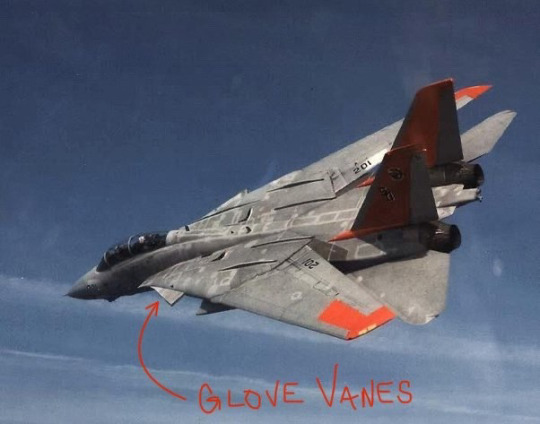

✅ SMALL NOZZLE EXHAUST FEATHERS
When compared to the F110 engines, it becomes pretty easy to tell the difference. When you look at the TF30 engine nozzle, you’ll see a lot of small metal plates, “Turkey Feathers,” that expand and contract when the nozzle opens and closes. It’ll be easier to tell the difference once you take a look at the General Electric F110 engine used on later F-14 Tomcat variants. This is the BEST way to identify an F-14A.


✅ SINGLE SENSOR POD BELOW CHIN
I recommend using the TF30 engine as the best way to identify an A-variant Tomcat as they are the only variant with those engines, however, I am choosing to include a section on the sensor pods for your reference as it is important for identifying the B and D-variants. The F-14A features a single sensor pod located below its chin but can come in a variety of configurations.
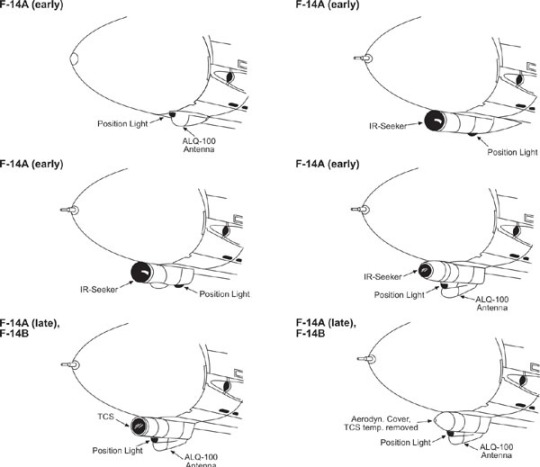
F-14A+ aka F-14B
NUMBER BUILT: 81 Aircraft (38 new builds, 43 upgraded F-14As)
UPGRADES BEGAN: March 1987
Initially designated the F-14A+, the upgrade is primarily characterized by the replacement of the Pratt & Whitney TF-30 engine with the General Electric F110-GE-400 engine due to being notoriously problematic. Many of the avionic systems and radars were retained, but the ALR-67 Radar Homing and Warning system was added. The A+was redesignated to the F-14B on 1 May 1891.
In the late 1990’s, the F-14Bs were upgraded again to extend its airframe life and upgrade the avionics system, but it was not given a variant designation due to the lack of major changes.
MAIN VARIANT FEATURES:
F110-GE-400 engines
ALR-67 Radar Homing and Warning system
IDENTIFYING FEATURES:
❌ NO GLOVE VANES
As stated in the section for the A-variant, the glove vanes were welded shut and completely disconnected on all existing Tomcats. On new builds, they weren’t even included in the design, however, if the aircraft is an upgraded F-14A, you might see the glove vane outline. This would be a way you can identify which aircraft were originally F-14As (Rebuild) and which were completely new builds.
✅ LARGE EXHAUST NOZZLE FEATHERS
Because most of the F-14B models were upgraded F-14As, it’s a little tricky to tell the difference sometimes. The easiest way is the F110 engine nozzle’s large turkey feathers. In comparison, the turkey feathers on the F110 engine are significantly larger and fewer in number, making it easily identifiable.


✅ SINGLE SENSOR POD BELOW CHIN
If you see a Tomcat with guide vanes and the F110 engine, then you can infer that it isn’t an F-14A. But to tell the difference between an F-14B and an F-14D, you’ll need to examine the sensors located below the chin.
Similar to the A-variant, the F-14B only has a single sensor pod located below its nose. The B model only had one true configuration with the Tactical Camera System (TCS), however, it may have an Aerodynamic Cover. This image from M.A.T.S. best shows the only possible sensor pod configurations for the F-14 A and B. The bottom two diagrams represent the B-variant.


F-14D Super Tomcat
NUMBER BUILT: 55 aircraft (37 new, 18 upgraded F-14As)
UPGRADES BEGAN: 1991
The F-14D, much like the F-14B, featured many avionics upgrades, including a new AN/APG-71 radar radar to replace the AWG-9 used in the A and B-variants and digital avionics systems. The D-variant, also called the Super Tomcat, featured the same F110-GE-400 engine used on the B-variant. There were many other upgrades to the F-14 Tomcat’s systems in this variant.
MAIN VARIANT FEATURES:
F110-GE-400 engine
AN/APG-71 radar
Glass cockpit
IDENTIFYING FEATURES:
❌ NO GLOVE VANES
As stated in the section for the A-variant and the B-variant, the glove vanes were welded shut and completely disconnected on all existing Tomcats. On new builds, however, they weren’t even included in the design. The rebuilds, however, might have the glove vanes if they were not removed during the rebuild process. F-14Ds upgraded from F-14As may also be designated F-14D(R)s, where R stands for rebuild.
✅ LARGE NOZZLE EHAUST FEATHERS
Many of the F-14Ds were rebuilt F-14As, so it’s a little tricky to tell the difference sometimes. The easiest way, similar to the F-14B, is the F110 engine nozzle’s large turkey feathers. In comparison to the TF30 engine, the turkey feathers are significantly larger and fewer in number.
✅ TWO SENSOR PODS BELOW CHIN
The main differentiating feature between the F-14B and D variants is the sensor pods located below the chin of the aircraft. This variant features two sensor pods as opposed to the one sensor pod of previous variants. This allows the aircraft to have both the Infra-Red Seeker pod and the Tactical Camera System (TCS). The F-14D is the only variant to have both, making it the easiest way to distinguish it from other variants.


#SOURCE: HOME OF M.A.T.S. Most comprehensive F-14 Tomcat website#SOURCE: Aircraft Recognition Guide#<- they got some stuff wrong tho i think#F-14 Tomcat#Reference#F-14 Tomcat Variants#Guide#F-14A#F-14D#F-14B#terminology#glove vanes#i like planes#airplane research#research#airplane history!#info#information#Turkey Feathers#idk what other tags to add lol#Navy#Top Gun#Top Gun Maverick#If you want me to make a post about something specific let me know#I like to analyze and research#just a little thing I wrote
68 notes
·
View notes
Note
where in the world do you live where you call it a hydroslurp???? that is a WATER FOUNTAIN
original poll by @t4tfaggot

#poll#ask#anonymous#dave speaks#you people are like 'omg the autism website' and 'cringe culture is dead'#but when youre faced with someone who may potentially call smth an unconventional name?? ohhh fucker#you guys just have to let them know how inordinately stupid they are huh? over terminology?#like 'ohh its a joke' even if its not a joke why the hell are you all being so condescending over this#and the funniest thing is op of the og poll did this as BAIT#as an EXAMPLE of how people overreacted on that fucking ice cream cone poll!!#and the exact same thing is happening to them now#if youve been an asshole to anyone over a terminology poll i have one question for you: what is wrong with you#and dont tell me im being too harsh on anon. i truly do not care
16 notes
·
View notes
Text

i'm just saying, if you're like me and have had 3 concussions within the span of a year and have trouble thinking and remembering things now, word hippo is a life saver —
#✯ — [ ʰᵒʳˢᵉˢ ᶤᶰ ᵗʰᵉ ᵇᵃᶜᵏ ] ⨯ ooc#it was a horrible#tragic accident. some of you may remember it if you followed me from my old blog.#long story short i got in a fight with one of those big garage style overhead loading doors in the warehouse at work and i did not win.#and then there were the follow ups but anyway —#that's not why we're here.#word hippo is just#so good. in a lot of different ways. but i particularly use it for it's thesaurus feature.#i mean#sure you could use thesaurus . com or literally any other dictionary site#but one thing i REALLY like about word hippo is how good it is about finding words that match phrases or definitions.#if you know a word but don't actually know the word but you know what it means ? you can literally type in a 3 page long definition#and it will find that word. and several others.#for some reason i never had the same luck on any other website. you can type in a whole PHRASE and it'll find words AND OTHER PHRASES#that also mean the same thing.#it's also pretty vast with it's slang and regional terminology which is also great.#and there's a ton of other search features on there too.#idk i just think it's kinda neat and it really helps me keep things moving when i'm writing things.#because i'm a very sequential writer#so if i get hung up on a word or a particular part of one sentence i physically can't move on until i remember or come up with that word.#and ever since the incident™ it's been really hard to recall even the simplest of terms sometimes.#but anyway back to my drafts sorry y'all had to read that.#love y'all — take care of yourselves today.#tbd
5 notes
·
View notes
Text
Honestly, I am pretty frustrated by the "haha why would anyone hate ace people" responses to Rowling's tweet.
Don't get me wrong, the support is nice. But if you want to be an ally, you have to do so on our terms, not yours. And that means actually engaging with the aspec community, not just posting positivity every now and again. And what those responses highlight to me is what I've known for a while; you guys only support aspec people when it's easy and convenient.
It's easy to support aspec people when it's J.K. Rowling being awful again. It's easy to support us when it's just reblogging an "aspec people are queer" post.
But what about when we are talking about amatonormativity and the relationship hierarchy? When we are discussing the enforcement of compulsory sexuality? When we are pushing for greater awareness and support for aspec identities that are not asexuality or aromanticism? When we are criticizing terminology that you use but harms us? Because I can tell you right now, I rarely see allo people engage with those posts.
Why do people hate asexuality (or any other aspec identity)? Because it challenges the societal norms that benefit them. And that is uncomfortable and scary. So they turn to hate and oppression in order to assure that the changes we push by just openly existing never happen.
That means that to be a good aspec ally, you can't just make a positivity post every now and again, and you can't just laugh about how stupid aphobes are. You have to openly challenge the societal norms that harm us, even if they benefit you. Including but not limited to:
The idea that romantic and sexual attraction is the default state of being (amatonormativity)
The idea that a romantic, sexual relationship completes a person
People in marriages receiving special privileges and benefits
The idea that platonic, familial, etc. attraction are default states of being
The idea that not feeling some form of attraction must be compensated for through another form of attraction
The idea that love (not just romantic) is inherently morally good, while not feeling love is inherently a moral failing
The idea that any one form of relationship is inherently more important or deeper than any other (relationship hierarchy)
The idea that any one thing makes someone human
The idea that not having sex is shameful or infantile
The idea that having sex without romantic love is callous
Gendered divides of sexual and romantic attraction
Other aspec people please feel free to add on/challenge any of this. Allo (not aspec) people please feel free to ask questions.
Additions:
Addition from @blkaroculture
Addition (in tags) from @fluffytimearts
Addition (in tags) from @cjreblogsthings
I've placed some resources for learning more about these topics under the cut.
Amatonormativity:
[PT: Amatonormativity:]
1. Amatonormativity Coining
2. Introduction to Amatonormativity
3. Challenging Amatonormativity
4. Effects of Amatonormativity and Compulsive Sexuality on Asexual and Aromantic College Students
5. Effects of Amatonormativity On Black, Polyamorous Men
6. Essay on Amatonormativity From a Aroallo, Loveless Perspective
Marriage Benefits:
[PT: Marriage Benefits:]
1. Article about Singlism and Marital Privilege
Other Aspec Identities:
[PT: Other Aspec Identities:]
1. Aplatonicism
2. Afamilialism
Loveless:
[PT: Loveless:]
1. Loveless articles on the AUREA website
2. Essay on Amatonormativity From a Aroallo, Loveless Perspective (repeat from Amatonormativity section)
3. Follow-up Essay on Lovelessness and Aroallo Antagonism
4. Results of a Survey of Loveless People (part 2 is linked instead of part 1 as part 1 is mostly demographic information)
5. Guide to Writing Loveless Characters (it focuses on fictional characters so should not be taken as a catch-all for real people, but it still has a ton of good information about lovelessness and loveless antagonism)
Compulsory Sexuality:
[PT: Compulsory Sexuality:]
1. Effects of Amatonormativity and Compulsive Sexuality on Asexual and Aromantic College Students (repeat from Amatonormativity section)
2. Breakdown of Compulsory Sexuality
Relationship Hierarchy vs Relationship Anarchy:
[PT: Relationship Hierarchy vs Relationship Anarchy:]
1. Relationship Anarchy Coining
2. Breakdown of Relationship Anarchy
3. Issues Presented by the Relationship Hierarchy
Oppression:
[PT: Oppression:]
1. Aphobia Masterpost
2. Asexual History and Oppression
3. Asexual Theory 101
Miscellaneous:
[PT: Miscellaneous:]
1. Research on Aromantics
2. Ace in the UK Research and Activism ft. Yasmin Benoit
3. Asexual History and Oppression (repeat from Oppression section)
4. Asexual Theory 101 (repeat from Oppression section)
Books and Video Essays:
[PT: Books and Video Essays:]
An Ace Discourse Retrospective by Jenny Geist
Ace: What Asexuality Reveals about Desire, Society, and the Meaning of Sex by Angela Chen
Refusing Compulsory Sexuality: A Black Asexual Lens on Our Sex-Obsessed Culture by Sherronda J. Brown
#neon's void#aspec#asexual#aromantic#aplatonic#afamilial#loveless#queer#lgbtq+#aroace#i have a ton more amatonormativity sources bc I did a research project on it a few years ago but I decided against putting them all in#I'm ending this post now because I've spent a good 2 hours on it T-T#ref
2K notes
·
View notes
Text
Being a Dutch Jew, here is some information about the violence in Amsterdam that is either common knowledge in the Netherlands, or is from some sources in Dutch that might not be commonly available for an international audience.
First of all about hooliganism, Amsterdam's football club Ajax is known as a 'joodenclub', a 'jewclub', because Amsterdam used to have a large jewish minority, many of whom were supporters of the club, and because several Dutch Jews were members of the team at one point. Ajax supporters take pride in this name. Because of this, there is a good relationship between Ajax and Macabbi, and the match was considered at low risk for football related violence and supporters of both teams mixed freely on the train back to the city center. In fact, only a pro-palestine protest was moved away from the stadium, because the police had recieved information that 'harde kern' Ajax hooligans were planning to stop that demonstration.
On that note, I have seen mixed information on what the Macabbi supporters were singing, but regardless, because Ajax is known as a jewclub, a common chant among the fans of opposing Dutch teams is "Hamas, hamas, alle joden aan het gas," or "Hamas, hamas, all the jews to the gas." Yes, a chant heard at pro-palestine protest is originally from Dutch football. Authorities have been cracking down on it in recent years, but a cursory google found people being arrested over it as recently as may 2023. Somehow, jews have never attacked random supporters of opposing teams at matches where this was chanted. Any Dutch person trying to justify things would be well aware of this.
About media coverage, I get my news about Amsterdam from Het Parool, a left-of-center, Amsterdam-based newspaper, that grew out of a WWII resistance paper. This is the current (about 16:30 Dutch time) front page of the newspaper website. In it the violence is described as an 'antisemitische klopjacht' an antisemitic manhunt. Most articles about it are paywalled, but firefox screenreader mode can bypass it.

Finally, I recognised a lot of the terminology in intenational news coverage from yesterday's press conference by Mayor Halsema (the woman in the picture above), which was also shown live by the dutch public bradcaster. In it an AP reporter asks in Dutch about Macabbi provocations, and they partially quote the police chief's answer, but not Mayor Halsma who came in right after, and said that the violence was in no way justifiable. I'm linking the full YouTube video of the press conference below. It is mostly in Dutch, and I have no idea about the quality of the autotranslation, but at about the 30 min. mark an Al Jazeera reporter asks a similar question in English, and the Mayor's answer in English is very clear.
youtube
1K notes
·
View notes
Text

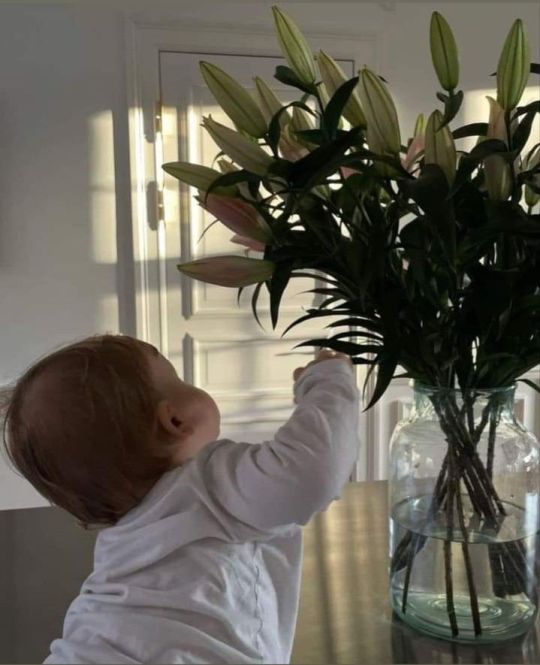




lovesong masterlist

pairing - dom!mother rhea x sub!mummyreader
summary - Rhea and Yn, a married couple, struggle with endometriosis, preventing her from carrying a child. They use a sperm donor and carry their first child, Lilly Jane Ripley. Five years later, Yn carries their second child, Austin Lee Ripley, despite significant pain. The story highlights their emotional journey, resilience, and the strength of their relationship despite medical and societal obstacles.
authors note <3
omg hi!! so I had a few people request rhea x reader and mother rhea, so Ive decided to make it into a series so here it is!! this is based on / a continuation of the 'the family she always wanted' story thing (I don't know what to call it) I hope you enjoy it. I dont want this to be half assed and im proof reading all of the chapters and shit
anyways. because im going to try and proof read this all its going to take me a while to post them so please be patient! for those who want rhea content, you are more than welcome to head over to my second page @yajokingyeh yes that me 😭 im dedicating that page to WWE and WWE memes.
so please head over there if you want short and small rhea drabbles and or smuts. that's where they will be posted for now :) I will continue to post my regular works on the other occults I write for as I need to catch up.
oh and also please be very patient with me coz I am at school and im really busy.
masterlist | main masterlist
wattpad - all of the chapters will all be availble on wattpad for those who would rather use that x

chapter list <3
1.0 seeds of a dream [wc; 5.5k]
summary; Rhea and Yn, are devised to find out that yn has endometriosis The condition causes inflammation and pain, impacting yn's fertility. They research fertility treatments like IVF, donor eggs, and surrogacy, but the medical terminology feels impersonal. Their love and commitment guide them through the challenges, proving their resilience and shared dream of parenthood. In a fertility clinic, they face the responsibility of finding potential sperm donors, each contributing to their future child. Their love serves as the foundation for their journey and their shared journey.
2.0 expanding the family [wc; 5.5k]
summary; Yn and Rhea, a couple who have faced infertility treatments and surrogacy, are now ready to face the challenges of parenthood again. Their love for each other and their daughter Lilly serves as a guiding compass as they navigate the unknown and uncertain future together. Throughout their journey, their love remained their anchor, providing comfort and care. Their positive pregnancy test was a testament to their resilience and belief in their love. As their family continued to grow, they created space for the newcomers, preparing a nursery, and celebrating their triumphs. Their love story is about celebrating resilience, commitment, and the power of love in the face of adversity.
3.0 navigating parenthood [wc; ]
summary;
4.0 strengthening bonds [wc; ]
summary;

DO NOT TRANSLATE, COPY PUBLISH OR EDIT MY WORKS, I DO NOT CONSENT TO MY WORKS BEING PUBLISHED ON ANY 3RD PARTY WEBSITE. © bunbun 2025 - 2027˙✧˖°📷 ༘ ⋆。˚
#wwe#wwe x reader#wwe imagine#wwe x you#wwe imagines#wwe one shot#wwe x oc#rhea ripley fluff#rhea ripley smut#rhea ripley x reader#rhea ripley imagines#rhea ripley imagine#wwe rhea ripley#rhea ripley wwe#rhea x reader#rhea ripley#wwe rhea ripley x reader#rhea ripley x oc#rhea ripley one shot#rhea ripley oneshot#rhea ripley angst#rhea ripley x y/n#rhea ripley x you#wwe the judgment day#mother rhea#x female reader#reader insert#female reader#x reader#fem reader
148 notes
·
View notes
Text
Japan Housing Websites (part one)
Want to move to Japan? Me too! Lately I’ve seen a lot of Instagram pages dedicated to showing off cheap homes in Japan. These pages usually just link back to a Japanese real estate website, so I’d like to list some handy vocabulary to help you navigate the sites and find some houses on your own!
Note: This post was made with intermediate level Japanese learners in mind. It's meant to be a vocabulary list with visual examples, not an all-inclusive house buying guide. A complete list of vocab words can be found at the end of the post. For general website navigation, I’d recommend the RikaiChan / RikaiKun extensions which will display a translation of each word you mouse over.
What Websites?
I really like SUUMO, so that will be the site I use for the example pictures. But any website will have more or less the same words!
Navigating the Website

[ 1 ] Creating an Account会員(かいいん)登録(とうろく):Member Registration
[ 2 ] Search探す(さがす):Search / Find This word will come up a lot! The search function may also appear as... 検索(けんさく):Search 物件(ぶっけん)検索:Property Search
Suumo has a nifty map on the front page. If you know the region you'd like to search in, you can choose it here.
[ 3 ] Renting 借りる(かりる):Rent (Borrow) 賃貸(ちんたい):Lease / Rent
[ 4 ] Purchasing買う(かう):Buy
[ 5 ] House Terminology If you've taken a Japanese class, you may have learned that the Japanese word for house is 家 or いえ. Unfortunately, this short and simple word isn't used much on real estate websites. The following terms are typically used instead.
一戸建て(いっこだて):Detached Building A standalone house, as opposed to an apartment or condo.
新築(しんちく)一戸建て:New Buildings
中古(ちゅうこ)一戸建て:Old Buildings 中古 can mean "old", "used", or “secondhand”, none of which sound ideal, but all it means is that the house that has been lived in previously. This is where you find the cheap ones!
Finding Houses

Once you have the region and building type selected, you’ll see a new map you can use to select the prefecture. I'll highlight a few key search methods on this screen.
[ 1 ] Search by Area(エリア)
Click on a prefecture to bring up a checklist of cities and districts. At the bottom of the list, you'll see two options: refining the search further or proceeding with the checked options.

「チェックした市区郡の町名を絞り込む」 "Narrow by town names of checked cities/wards/districts"
市区郡(しくぐん):"City Ward District" 町名(ちょうめい):Town Name 絞り込む(しぼりこむ):Narrow / Refine
「この条件で検索する」 "Search with these conditions"
条件(じょうけん):Condition / Term
The orange number shows how many total properties were found with the checked selections. Click the blue search button if you want to jump straight to the houses without refining the search.
[ 2 ] Search by Railway(沿線)or Station(駅)
Click on a prefecture to bring up a checklist of railways. At the bottom of the list, you'll see two options: refining the search further or proceeding with the checked options.

「チェックした沿線の駅を絞り込む」 "Narrow by stations of checked railways"
沿線(えんせん):Railway / Track 駅(えき):Station 絞り込む(しぼりこむ):Narrow / Refine
「この条件で検索する」 "Search with these conditions"
条件(じょうけん):Condition / Term
Once again, the orange number shows how many total properties were found with the checked selections. Click the blue search button if you want to jump straight to the houses without refining the search.
[ 3 ] Search by Map(地図、ちず) Clicking here will open up a much more detailed map that you can scroll through! Definitely the easiest option, which is why I put it last. :)
The End.
Here's the complete vocab list for ease of viewing:
会員(かいいん):Member 登録(とうろく):Registration 探す(さがす):Search / Find 検索(けんさく):Search 物件(ぶっけん)検索:Property Search 借りる(かりる):Rent (Borrow) 賃貸(ちんたい):Lease / Rent 買う(かう):Buy 一戸建て(いっこだて):Detached Building 新築(しんちく)一戸建て:New Buildings 中古(ちゅうこ)一戸建て:Old Buildings 市区郡(しくぐん):"City Ward District" 町名(ちょうめい):Town Name 沿線(えんせん):Railway / Track 駅(えき):Station 絞り込む(しぼりこむ):Narrow / Refine 条件(じょうけん):Condition / Term
#Japan#Japanese#japanese language#japanese translation#japanese langblr#japanese studyspo#japanese studyblr#japanese learning#japanese study#learning japanese#japan house#moving to japan#japanese vocabulary#日本語#日本#日本語の勉強#日本語勉強
162 notes
·
View notes
Text
I admire all of you who post about transmisogyny and explain the concepts and stand up against the horrible transmisogyny on this website. I don’t have the capacity to join you, reading braindead transandrophobia and anti tme/tma terminology takes is so infuriating that it can easily ruin my mood and my entire day. Putting up with this shit day in and day out is exhausting and I’m sorry I don’t have it in me to try and stand beside you. Thank you for doing what you do
101 notes
·
View notes
Note
Hi! I love your posts and have been lurking around here for a while
I was wondering if you could maybe do something on hypersexuality? Unless it's too dark or sensitive of a topic for you since you're only human (please ignore this if you're uncomfortable<3)
Writing Notes: Hypersexuality
Hypersexuality - Extreme frequency of sexual activity, or an inordinate desire for sexual activity.
Although there are no established criteria for hypersexuality, traits that are commonly seen in a hypersexual person include:
Sex obsession. Spending a lot of time fantasising about sexual urges and enacting sexual behaviours.
Compulsive and frequent masturbation (one to several times a day).
Use of virtual pornography. Sources include videos, adult magazines, and the Internet (websites, webcams). Masturbation with virtual material is practised with repeated and systematic frequency.
Massive dedication in a daily time frame, planning sexual activity. One spends several hours deciding where and how to get the next sexual “pleasure”.
Use of sexual services. This already represents a more structured and pathologically dysfunctional behaviour, as sexual activities now involve direct or indirect human interaction. Behaviours may include phone sex, connections via Internet chat rooms, paying for sexual encounters, visits to strip clubs, multiple partners, or frequent one-night stands.
Degeneration of behaviour into reckless, socially objectionable, or illicit sexual activity. Substance abuse, sexual assault, or dangerous sexual activity (such as autoerotic asphyxiation) may be added to sexual activity.
Engaging in sexual behaviour that goes against one’s values, religious beliefs, or what society deems appropriate, experiencing helplessness, or inability to restrain oneself.
Manifesting paraphiliac attitudes or behaviours. These are sexual behaviours that result in psychological distress, injury, or the death of another person. Examples include exhibitionism (exposing genitals to strangers), voyeurism (watching or participating in sexual activity with others), sadomasochism (sexual pleasure in inflicting pain or humiliation on others), and paedophilia (sexual feelings towards children).
Inability to stop one’s sexual behaviour despite negative consequences in other areas of personal life, such as emotional, love, family, social, professional, or health-related relationships.
Nymphomania, Satyriasis, Don Juan
Nymphomania - In females, excessive or uncontrollable desire for sexual stimulation and gratification. The word is often used loosely to denote a high degree of sexuality in a woman, reflecting negative cultural attitudes toward female sexuality.
Satyriasis - Excessive or insatiable desire in a male for sexual gratification. Sexual activity with one person is found to be inadequate, and many other sexual partners are sought.
Don Juan - A man who ruthlessly seduces women, concerned only with sexual conquest, after which he loses interest in them (Don Juanism). The original Don Juan was a legendary Spanish libertine, the subject of literature and Mozart’s opera Don Giovanni. In contrast to men with a Casanova complex, who adore women, a Don Juan may think of women as prey.
The concept of “hypersexuality” belongs to modern parlance.
According to a predominantly clinical meaning, it is understood as a psychological and behavioural alteration as a result of which sexually motivated stimuli are sought in inappropriate ways, often experienced in a way that is not completely satisfactory.
It is a psychopathological label strongly desired by the scientific community to replace terms previously used in other areas of study as well, such as nymphomania and satyriasis, the former referring to the female sexual gender and the latter to the male sexual gender.
Such terminologies draw on Greek mythological culture, referring to the nymphs, who were young and beautiful maidens whose beauty attracted the desire of many men.
In fact, according to mythological tradition, it was they who first used the art of seduction to continually procure new sexual partners and thus the satisfaction of their pleasures.
However, the nymphs, like the sirens, hid a dark side: their company was as deadly as it was pleasurable.
They often fell prey to the satyrs, bearded beings who were half-man, half-animal (goat or horse), and also devoted to lustful wildlife.
The dances of the satyrs and nymphs are depicted in very famous works, which capture precisely the peculiarity and complementarity of their sexual behaviour.
Nymphomania and satyriasis are, therefore, the female and male equivalents of today’s hypersexuality, which, in the past, was considered a morbid accentuation of sexual impulses.
In later centuries, popular tradition extolled these aspects in many artistic representations, thus giving rise to myths and stories, widely using the terms now replaced with hypersexuality beginning in 1771 A.D. in the edited work “Nymphomania. Treatise on Uterine Fury” by French physician Giambatist De Bienville.
The diagnostic criteria advanced by the World Health Organisation on the subject of hypersexuality are:
A. for at least 6 months, recurrent and intense sexual fantasies, sexual urges, or sexual behaviour in association with 3 or more of the following:
time spent in repetitive sexual fantasies, impulses, or behaviours that interfere with other important (non-sexual) goals, activities, or obligations;
repetitive engagement in sexual fantasies, impulses, or behaviours in response to dysphoric mood states (e.g., anxiety, depression, boredom, or irritability);
repetitive engagement in sexual fantasies, impulses, or behaviours in response to stressful life events;
repetitive but unsuccessful efforts to control or significantly reduce such fantasies, impulses, or behaviours;
repetitive engagement in sexual behaviours, disregarding the risk of physical or emotional harm to self or others
B. there is clinically significant personal distress or impairment in social, work, or other important areas associated with the frequency and intensity of these sexual fantasies, impulses, or behaviours
C. these sexual fantasies, impulses, or behaviours are not a direct result of medical conditions (e.g., brain tumours or dementia) or substance intake (e.g., a substance of abuse or medication)
Sources: 1 2 ⚜ More: Notes & References ⚜ Writing Resources PDFs
Thank you, so glad to hear! I appreciate your thoughtfulness. It's alright, I love doing requests on topics that I might never even have thought to research on. I always learn a lot from these. Hope this helps with your writing <3
#anonymous#writing notes#writeblr#literature#writers on tumblr#writing reference#dark academia#spilled ink#creative writing#writing prompt#light academia#writing inspiration#writing ideas#writing resources
77 notes
·
View notes
Text
tumblr is fundamentally the 'hey op wtf does this mean' website. much of the good, classic examples of tumblr humour are from a specific source - inside jokes and insider terminology being spread outside their sphere, and being received by those not in-the-know as simple comedic absurdism.
in this same manner, tumblr is very susceptible to reactionary sentiments, because the userbase's response to seeing something they don't understand is to laugh and repeat it - which is how a thousand fandom bloggers reblogged a Super Funny screenshot of a channer with a racially-categorised folder of peoples' selfies he collected, using 4chan's homegrown slur for arabic people, 'kebabs', and just blithely laughed along at how silly it was, guessing about which nation such a non-sequitur could possibly be referring to; or how 'reject modernity, embrace tradition' became a casual utterance, because tumblr users just gormlessly parroted a phrase they saw that sounded funny, without giving even two seconds of thought to it; or how 'la creatura' proliferated so much despite its origins being such an absurdly racist image that the average tumblr user might not even be able to identify half the different bigotries at play.
tumblr is a website where, beyond simply not caring to look into things they don't understand, the userbase takes pride in not understanding things, they take not understanding things they oppose to be a sign of moral purity, and they rely on not understanding things they like as a singular source of humour. it is a website where using the word 'transmisogyny' elicits a response of 'none of these words are in the bible'; and using the word 'troon' elicits 'haha what does that even mean it sounds like a teletubby #reblog'.
528 notes
·
View notes
Text
So…you want to know more about Korean shipping terminology (and how does this apply to Ateez?)
Luckily, I have spent the better part of six years of my life learning Korean! Which fortunately(?) means that I have learned plenty about the lingo Korean BL fans use re: shipping dynamics. Actually, this makes it SO MUCH easier to navigate websites like Twitter, where NSFW posting is censored for security reasonable. The difference is that English speakers do not have an organized method of referring to the members in their ships (for example, one user might write seongjoong as secngjccng where one might instead write sxxngjxxng, and where another one might even write sngjng, etc etc). But how do Korean speakers handle this situation? What is the context behind all of this? I will provide with you with a fun and easy chart at the end, but first….Let me explain:

Taking you back to the early 2000s
Our setting: the early Korean BL online forums. The terminology originating from these spaces were unsurprisingly heavily influenced by the original sources from which BL manga was derived: the Japanese language. Japanese has a system of Chinese characters used to simplify the writing process known as Kanji. Korean has a similar concept, known as Hanja. Where as Kanji is still heavily utilized to this day for a variety of reasons (my Japanese teacher would always say its main purpose is to minimize the amount of script needed to convey an idea), Hanja has largely fallen out of fashion—used primarily to clarify homophones in text, in literature such as novels and older writings, and as a stylistic choice to depict words such as Death and God, etc.
First, I’m going to give you some terms that are familiar to quite possibly all of you.
Seme (攻め) - the dominant figure in the relationship. Most often, this person will also be depicted as the top.
Uke (受け) - the submissive figure in the relationship. Most often, this person will also be depicted as the bottom.
Are you following so far? Great! In the most stereotypical depiction of homosexual relationships in Manhwa, these roles—the dom top and the sub bottom—reigned supreme so much so that eventually the community fell into the pitfall of believing these four terms to be interchangeable. While simplifying the process of understanding each person’s role in sexual intimacy, it also didn’t lend much of an allowance to explore ideas that defined this view of sexuality. This lack of nuance and flexibility has very little to do with why I’m writing today, but I do want to give some more context as to why these terms became such reliable shorthand.
Anyway…
In Korean BL spaces, these Kanji symbols (攻/受) were directly translated into 공 and 수, respectively. 공 literally means “Ball” but in the context of the Hanja, it means “attack” or “strong”, basically dominant top. 수—“Number”—“to submit” or “to receive”—submissive bottom. Don’t worry, this is the absolute last time I will be explaining these ideas.
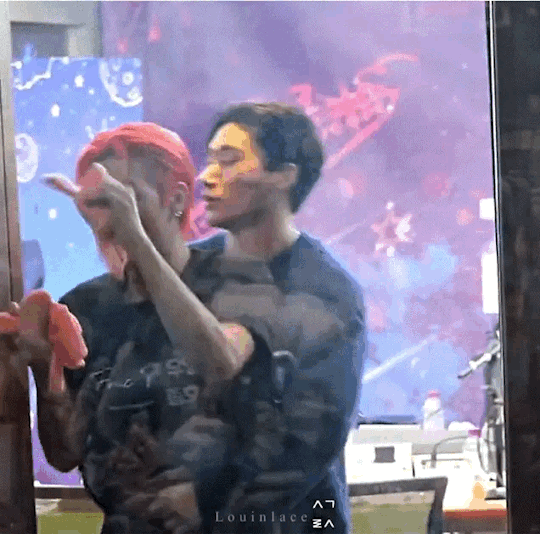
How does this work in Korean BL spaces?
Now this may also be familiar to many of you: the placement of each figure in the ship name MATTERS! In SFW spaces, you can get away with referring to Yunho and Mingi as Yungi because….well….platonic friendships aren’t normally referred to by dominance dynamics. In NSFW spaces, specifically dealing with fictional depictions of gay sex, referring to Yunho and Mingi as YunGi will have most people assuming that you mean fanfictions in which Yunho is the top and Mingi is the bottom. Oh, you didn’t? Well, obviously you meant to say MinYun (or MingYun or MingHo, I’ve seen this written all kinds of ways tbh). See what I mean? Now this isn’t always the case—familiarity is everything, so it’s not uncommon to see Wooyoung and San referenced as WooSan, no matter who is intended to be the top.
In Korean, ship names are almost always written in order of placement. For example, 윤낫 (we will get into why the Hangul in San’s name is reversed later) would refer to a Yunho x San pairing where Yunho is the top and San is the bottom. Likewise, 낫윤 would imply the exact opposite. Anyone want to take a stab at what 밍웡 means? How about 섷쫑?

2010-2024, A minor shift in focus
As the spaces for these conversations grow and change with time, as did the terminology used to describe shipping dynamics and pairings.
If you are a fourth and fifth gen K-pop stan, you know what a coupling, or chemi, name is. Korean fans who did either did not want to discuss their idols in a romantic/sexual manner, or otherwise wanted some way to differentiate a typical shipping name from a platonic pairing name, developed the concept of using a chemi name instead. For Ateez, these would be:
E-Kang-Mo (에강모) / Yunho and Yeosang - the shortened version of 에이티즈 강아지 모임, literally translating into the Gathering of Ateez Puppies.
Matz (맏즈) / Seonghwa and Hongjoong - TWO MEN WE’RE ON FIRE 위험해‼️‼️‼️ Shortened version of 맏형 which literally translates into Oldest brothers. This quite obviously refers to our two oldest members within the group.
Elsewhere, you may come across 삼복즈, Jiwoong and Yujin from ZEROBASEONE. Or 채채즈, Chaewon and Eunchae from LE SSERAFIM. Usually this name is derived from some personality aspect or moment the two idols share, and can be given organically by fans or by the idols themselves. They are used strictly by both Korean and international fans as a means of referring to these idols and their friendships. It’s still possible that you find a fan who skips the whole “having to learn a completely different unit name” thing and just uses the traditional pairing name (I know, because I’m one of them), and in this case you can likely tell exactly when they first got into K-pop.
During this decade, shippers developed two more terms to further break down sexual dynamics, this time focusing on top/bottom. 왼 is the Korean directional word for “left”, and in the context of BL, means top. For bottom, Koreans use a shortened version of the directional word for “right”—른. I am not entirely sure whether the general consensus seems to be that these terms are still strictly tied to the idea of a dominant top and a submissive bottom, as most of the resources I used to search for these terms waffled on the subject.
In practice, 웡왼 will refer to shippings in which Wooyoung is a top (I searched for this on Twitter and came up unsurprisingly short….) and 쫑른 is in reference to shippings where Jongho is a bottom!

Enough Already!! Just give us the tags!!
Loud and clear, boss. However, I just need a bit more contextual information out there before I finally get into the list:
Variations - there are few variations that exist within the Korean shipping fandom, save for instances in which another pairing could possibly exist within a different group.
Censorship - Korean fans are also heavy on making sure these posts do not make it into the hands of Ateez themselves (see: the chaos that happened when San stumbled across self-insert fiction written by K-Atiny). Member names are not written properly, and will always be altered in some way as a means of masking it from normal search results. Please pay attention to this!
Pronunciation - some letters are altered in the pairing names as a means to aid with pronunciation. This is sort of an intuitive thing with Korean, so I’m not sure how to explain this in a better way.
And now…the list!
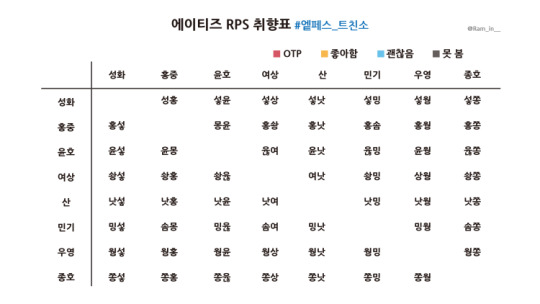
Here’s how to follow the chart:
Reading from the top down, you will find the 른—or pairings where the member is the bottom. For example, Seonghwa’s column reads:
홍섷 - Hongjoong x Seonghwa
윤섷 - Yunho x Seonghwa
솽섷 - Yeosang x Seonghwa
낫섷 - San x Seonghwa
밍섷 - Mingi x Seonghwa
웡섷 - Wooyoung x Seonghwa
쫑섷 - Jongho x Seonghwa
Likewise, reading the chart horizontally will provide you with the 왼—or pairings where the member is the top. For example, Mingi’s row reads:
밍섷 - Mingi x Seonghwa
솜몽 - Mingi x Hongjoong
밍윦 - Mingi x Yunho
솜여 - Mingi x Yeosang
밍낫 - Mingi x San
밍웡 - Mingi x Wooyoung
솜쫑 - Mingi x Jongho
Additionally, adding (Member name)른/왼 will provide you more general posts where Korean fans are discussing the idol as a top or a bottom in general without referring to a specific ship.
Hongjoong: 홍왼 + 홍른
Seonghwa: 섷왼 + 섷른
Yunho: 윦왼/윤왼 + 윦른/윤른
Yeosang: 솽왼 + 솽른
San: 낫왼 + 낫른
Mingi: 밍왼 + 밍른
Wooyoung: 웡왼 + 웡른
Jongho: 쫑왼 + 쫑른
Thank you for reading! I hope this was as useful for you as it was for me! Of course, I knew a lot of history regarding this topic due to the ample time I spent reading BL, but I will admit that I did not have much time to research this topic specifically. However, if you have any corrections to make, let me know!! This was so much fun for write, and maybe I can do something similar to this in the future as well.
Bye!
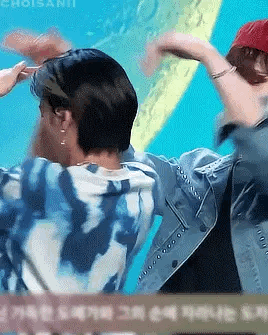
#ateez#halia speaks#ateez rps#hongjoong#seonghwa#yunho#yeosang#san#mingi#wooyoung#jongho#ateez fluff#ateez smut#ateez angst#woosan#seongjoong#jongsang#yunwoo#yunsang#yunsan
150 notes
·
View notes
Text
Silmarillion Survey Essay!
My essay was due last night (submitted it with 6 minutes to spare!) and my professor said I could post it to Tumblr if I wanted to. It's divided into four sections, all marked. The first section is the introduction where I explain the point of the survey, who I studied, and why. The second section is the methods I used to design the survey, get answers, record answers, and control for variables. The third section is results, where I highlight several of the questions I thought would be most stratifying and explain what I actually found (it has graphs!). The fourth section is the discussion where I talk about what I found and what conclusions I drew from that.
I'd love to hear all of your thoughts on the results and my conclusions!
Introduction
For this project, I looked into age (and length of time in fandom, in one case) affected knowledge and attitudes about fandom language. I investigated several terms and phrases, both from fandom at large and from the Silmarillion fandom specifically. The group I studied was the fandom of The Silmarillion on Tumblr because I am intimately familiar with that internet space (and could therefore phrase the questions in a way that would be understood) and because the majority of Archiveofourown.org (a popular fanfiction website) users are also Tumblr users.
For the purposes of this paper, I am defining the Silmarillion fandom as a community of practice. The Wenger-Trayner article, “Communities of practice a brief introduction”, defines a community of practice as an entity with three parts: domain, community, and practice. The domain is “an identity defined by a shared domain of interest” (Wenger-Trayner 2). The domain in this case is The Silmarillion. As The Silmarillion is a history book set in a fictional universe, it is incredibly dry at times (there is an entire chapter titled “Of Beleriand and its Realms” which deals mostly with geography) so anyone who reads it by choice is necessarily interested in the work. The second part, community, is made up of “members [that] engage in joint activities and discussions, help each other, and share information” (Wenger-Trayner 2). Most fandoms engage in discourse/discussion, create transformative art (mostly written or visual, but I have seen musical as well) and exchange craft advice to better each other’s creative work, but due to the almost academic nature of the Silmarillion fandom, we exchange background lore knowledge, additions to Tolkien’s conlangs, translations, timelines, and character sheets in addition to the regular fandom activities. Finally, the Silmarillion fandom also has a shared practice, defined as “They develop a shared repertoire of resources: experiences, stories, tools, ways of addressing recurring problems—in short a shared practice” (Wenger-Trayner 2). As mentioned above, the Silmarillion fandom has shared resources (such as tolkiengateway.net, Nerd of the Rings on YouTube, as well as several established “fandom elders” who are happy to answer questions), stories, established characterizations for “only-mentioned-once-in-a-footnote” type characters, settled linguistic debates, and several research-oriented blogs (such as two of my own) that record niche or new knowledge about either Tolkien’s work or the fandom itself. Almost all of the above (with the possible exception of the website and the youtuber previously mentioned) is unpaid hobby work.
When doing this survey, I expected to find a rather steep difference between older and younger members of fandom regarding their knowledge of fandom terminology. I expected the 18-25 age group to be the most knowledgeable of fandom terms with the under 18 group to be only slightly behind them and the 26-30 group a slightly further way behind the under 18 group. For the groups over 30, I anticipated that the rate of knowledge would sharply decline and that older fans would be unfamiliar with fandom terminology for the most part. I was… incorrect.
Methods
There are eight questions highlighted in this paper. The first chart (Figure 1.) is the total percentage of answers that amounted to “I don’t know”, filtered by age. The first table (Figure 2.) looks at the people who did not know the term “Isekai” based on whether or not they were native speakers of English or live in Asia (given that “Isekai” is a Japanese word). The second table (Figure 3.) compares the percentage of people who mentioned that the word “angst” is also present in everyday German, categorized by German speakers and non-German speakers. The third table (Figure 4.) examines attitudes towards the anti/pro-ship terms based on age. The second chart (Figure 5.) examines attitudes towards the term “omegaverse” separated by age. The fourth table (Figure 6.) compares groups of people who could define the difference between “peredhel” and “peredhil”, separated by how long they have participated in the fandom surrounding the Silmarillion fandom. The third chart (Figure 7a.) looks at people who understand the phrase “Fëanor did nothing wrong” as a joke, filtered by age. Finally, the fourth chart (Figure 7b.) shows the percentage of people who used the phrase “tongue-in-cheek” in the 31-40 group as opposed to other age groups (that one was not explicitly asked for in the survey; I simply noticed a steep trend while dissecting the results from the “Fëanor did nothing wrong” question).
I compiled all of these questions (along with several others) in a google form as a three-part survey. The first part was comprised of basic demographic questions, the second of general fandom terms and phrases, and the third of terms and phrases specific to fanfiction of The Silmarillion. The 418 responses were recorded and examined in Google sheets, which I used to filter the demographic information for ease of synthetization.
The group I examined was people who participate in the Silmarillion fandom on Tumblr. I chose this group because I am familiar with them, because they are the most likely to be aware of these terms (due to the large overlap between Tumblr and Archive Of Our Own), and because fandom language is (to the best of my knowledge) not well studied. I was able to isolate this group by only posting the survey to Tumblr itself. Tumblr posts are only viewable to Tumblr users, so even if someone were to post a link to the post elsewhere, the only people able to access the survey would be Tumblr users. I further attempted to control by including several fandom related and The Silmarillion-specific questions in the demographic portion of the survey. Anyone who completed the demographic portion would have been well aware of the nature of the survey by the end, regardless of how poorly they understood the original survey posting. These measures, of course, did not stop everyone. I had a few respondents who submitted only the demographic portion or the demographic and general fandom portions. Luckily, due to the Google Sheets functions, such responses were relatively easy to filter out.
Results
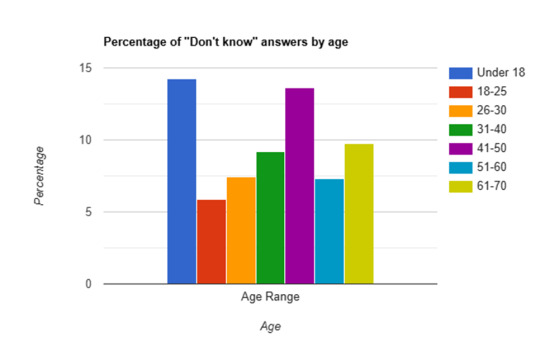
(Figure 1. A chart observing, out of all 16,065 answers, how many equate to “I don’t know?” Under 18: 14.24%, 18-25: 5.9%, 26-30: 7.43%, 31-40: 9.17%, 41-50: 13.63%, 51-60: 7.3%, 61-70: 9.7%)

(Figure 2. A table comparing different categories of people and what percentage of them are unfamiliar with the term “Isekai”; a Japanese term which is most commonly defined as “a trope in which a character somehow travels from the mundane ‘real’ universe into a fictional one.” 23.08% of native English speakers are unfamiliar with the term. 27.07% of non-native English speakers are unfamiliar with the term. 20% of respondents who live in Asia are unfamiliar with the term.)

(Figure 3. A table comparing different categories who mention that “Angst” (defined in fandom context as “dramatic, serious, and sometimes dark”) is an everyday word in German. 12.73% of German speakers mentioned it. 1.38% of people who either do not speak German, or did not mention it in their language background, mentioned it.)

(Figure 4. A table comparing the attitudes of different age groups to the terms “anti-ship” and “pro-ship”. These terms are hotly debated in fandom. Those on the anti side of the debate define anti-ship as “being morally against abuse and pedophilia,” and pro-ship as “excusing abuse and pedophilia in fandom.” Those on the pro side of the debate define anti-ship as “puritanical and chronically online people who can’t separate reality and fiction” and pro-ship as “letting people ship whatever they want and separating reality from fiction.” Those under 18 are 4% anti, 4% pro, and 92% neutral. Those from 18-25 are 2.44% anti, 29.27% pro, and 68.29% neutral. Those from 26-30 are 0% anti, 33.67% pro, and 66.33% neutral. Those from 31-40 are 2.2% anti, 26.37% pro, and 71.43% neutral. Those from 41-50 are 0% anti, 46.15% pro, and 53.85% neutral. Those from 51-60 are 12.5% anti, 37.5% anti, and 50% neutral. Those from 61-70 are 0% anti, 50% pro, and 50% neutral (although, admittedly, there are only two respondents in that group.))
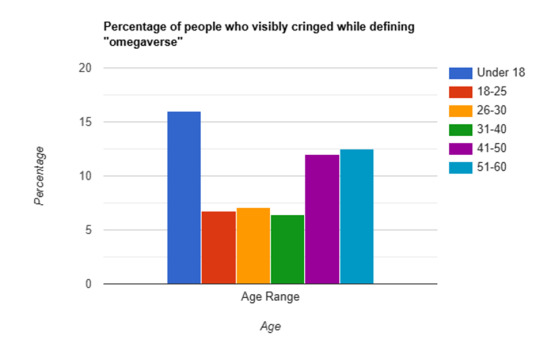
(Figure 5. A chart that shows the rate at which respondents cringed (using phrases such as “please don’t make me define this,” “oh god,” and “Nuh uh. Sorry man. Sweet baby rays good lord.”*) within their responses while defining “Omegaverse” (an erotica subgenre within fandom based on outdated wolfpack dynamics. Very popular, but also very taboo). Under 18: 16%, 18-25: 6.71% 26-30: 7.07%, 31-40: 6.45%, 41-50: 12%, 51-60: 12.5%)
*All real responses I received
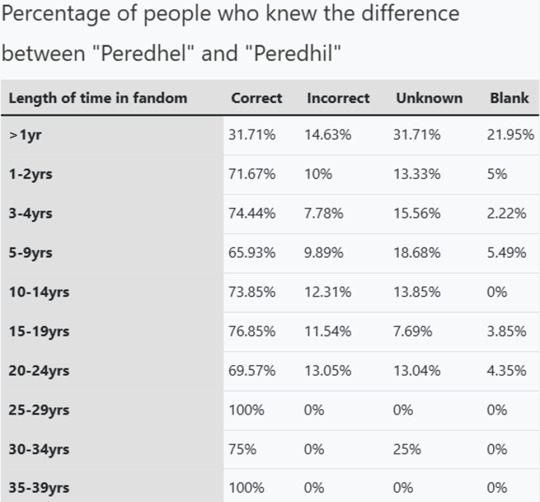
(Figure 6: A chart exploring the differences between who can correctly identify the difference between the terms “peredhel” (half-elf, singular) and “peredhil” (half-elves, plural) based on how long they have been in the fandom. Those who have been in the fandom for less than a year are 31.71% correct and 14.63% incorrect. Those who have been in the fandom for 1-2 years are 71.67% correct and 10% incorrect. Those who have been in the fandom for 3-4 years are 74.44% correct and 7.78% incorrect. Those who have been in the fandom for 5-9 years are 65.93% correct and 9.89% incorrect. Those who have been in the fandom for 10-14 years are 73.85% correct and 12.31% incorrect. Those who have been in the fandom for 15-19 years are 76.92% correct and 11.59% incorrect. Those who have been in the fandom for 20-24 years are 69.57% correct and 13.04% incorrect. Those who have been in the fandom for 25-29 years are 100% correct and 0% incorrect. Those who have been in the fandom for 30-34 years are 75% correct and 0% incorrect. Those who have been in the fandom for 35-39 years are 100% correct and 0% incorrect.)
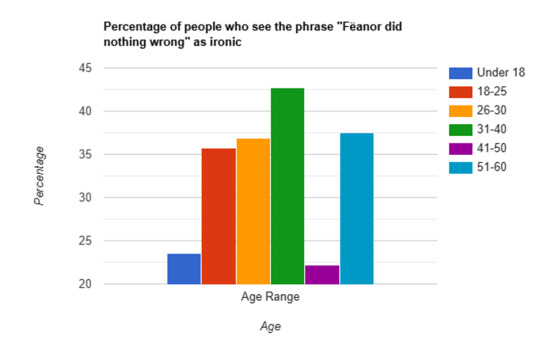
(Figure 7a. A chart observing who sees the phrase “Fëanor did nothing wrong as ironic” divided by age. Under 18: 23.53%, 18-25: 35.77%, 26-30: 36.9%, 31-40: 42.67%, 41-50: 22.22%, 51-60: 37.5%)
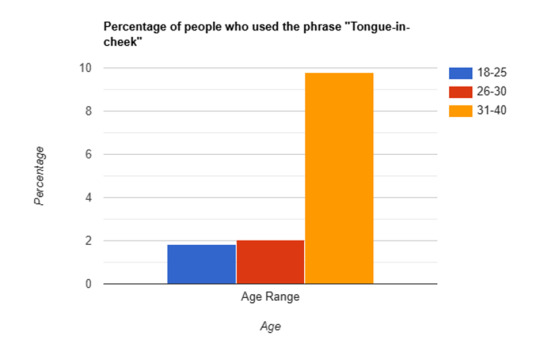
(Figure 7b. A chart observing the percentages of age groups who used the phrase “tongue-in-cheek” while answering the above question. 18-25: 1.84%, 26-30: 2.04%, 31-40: 9.78)
Discussion
Observing these results, I can see that, while there is some level of stratification by age and length of time spent in the fandom, it is not nearly as dramatic as I had expected it to be. These results strongly demonstrate the power of communities of practice. These people, across ages and continents, communicate so often and so deeply, that nearly all terms are understood to the same degree by everyone, and nearly everyone has similar stances on divisive pan-fandom debates.
Were I to do this study again, or a similar study in the future, I would probably narrow the purview by a lot. I would ask fewer questions (or at least, only ask questions of a single type), compare them against only one demographic question, and sincerely consider making them multiple choice. That being said, I do not regret this survey having short answer questions. There were several definitions of several terms that I never could have come up with in a million years. Synthesizing the short answers may have taken more effort on my part, but I learned a lot about my fandom.
@proship-anti-discussion (ship debate was mentioned)
#silmarillion#fandom#linguistics#survey says#silmarillion survey#fandom survey#academia#nerd shit#graphs#charts#tables#isekai#angst#antishiping#proshipping#omegaverse#peredhel#peredhil#feanor#fëanor#fëanor did nothing wrong#fandom discourse#fandom meta
81 notes
·
View notes
Text
Sephiroth's Weight

I have been thinking about this a lot today none of your business is why and I have come to a conclusion, based on 100% scientific facts, solid evidentiary support, and total delusion: Sephiroth weighs, at the very least, 400 lbs.
I don't want to bog us down in too much scientific terminology, but that is what all of us here in the research lab refer to as a "brick shithouse" of a man.
Evidence, you say? Factual support, you demand? This is my lab who are you to make demands! But I do actually have some.
So, according to a bunch of fitness websites, the ideal weight for a 6'7" dude would be 270 lbs. However, men with a more muscular physique, such as bodybuilders, tend to weigh quite a bit more.
This is Dutch actor and tallest bodybuilder in the world, Olivier Richters, for context. He is 7'2" and weighs 350lbs.
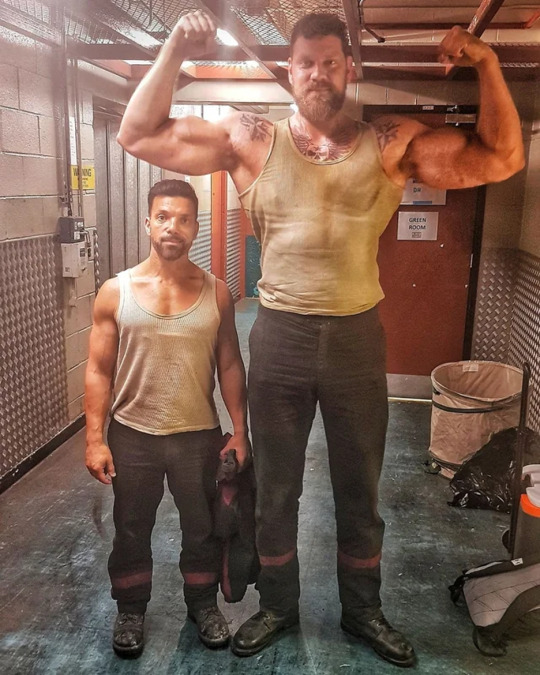
And here is totally shredded hunk of 100% certified bio-engineered beef Sephiroth, who clocks in at between 6'7" and 7'0" (by the remake character models, not the outdated and poorly translated old guides).



We know he's slightly shorter than Olivier, and as we can see, he is a bit leaner, but not by a whole damn lot. So, why do I say he must weigh substantially more?
Two words: Ho-jo. That's right, these Hojo-made super-soldiers are built tough as fuck. Even normal humans increase their bone density with regular exercise, and these guys basically live to work out. They are constantly in training or war, lift huge amounts of weight, sustain extreme impacts of all kinds, and cut missiles in half with swords.
No amount of increased muscle strength would matter a damn, if your tissues and bones couldn't handle the extraordinary strain, so it stands to very good reason that due to the genetic fuckery and the mako treatments, their muscle and bone density is much higher than a regular human's. How much higher? How the hell would I know, I'm not a boneologist.
That's why my scientifically magnificent and flawlessly researched rough estimate is around 400 lbs for Sephi, at the very least. Am I right? Maybe. Am I fixating on a detail no one else cares about? Probably. Was this entire post an excuse to post a bunch of shirtless pictures of Sephiroth? WHAT ARE YOU THE COPS?
Anyway, here are some more shirtless pictures of Sephiroth.




#sephiroth#sephiroth weight#theory#fan theories#weight#ff7#final fantasy 7#final fantasy vii#ff7 remake#ff7 rebirth#olivier richters#ff7r#warning: hojo
117 notes
·
View notes
Note
Hi So I go to a Christian school so get tonnes of sex misinformation on the daily
but the other day my bible teacher was talking about porn addiction (bad start I know) and I wanted to know if what he said was in any way accurate
he said that when someone first sees any kind of pornagrhaphic content it sticks in their mind and that’s all it takes to want to see more, does this have any basis in reality whatsoever?
hi anon,
well, yes and no.
if you enjoyed what you were looking at - if it made you feel aroused, if it was interesting to look at, even if it was funny! a lot of erotica is funny! - then sure, it may stay in your memory and make you want to see more. you know, the same way that having a tasty little snack might make you want to have another tasty little snack, or watching an episode of a cool TV show might make you want to watch another episode, or listening to a great new song might make you want to listen to it over and over. porn doesn't have a unique death grip on your brain, your brain just likes things that are exciting and enjoyable. being turned on can feel good, and there's literally nothing wrong with that - on a biological level we're wired for it, since sex is necessary to pass on our genes and continue the species. and even if the sex we're interested in isn't reproductive (sex alone, sex where no one can get pregnant, sex with protection against pregnancy, etc) your brain doesn't care - that shit feels good regardless. so, yes, wanting to return to things that make you feel aroused is as normal as, like, wanting another sip of a tasty drink or to keep playing your favorite video game. as long as it's not taking over your entire life, it's harmless.
crucially, it's not like this is a power that all porn has over every person. porn that does nothing for you - kinks that aren't your kinks, actors or characters using terminology that turns you off, scenarios that simply aren't sexy to you - is incredibly easy to just look away from, and it's not like you're doomed to an instant boner every time you see something even a little bit sexual. people read erotic novels or fanfic in public all the time, and on this very website it used to be incredibly common to encounter gifs of random porn among your scrolling (still possible in some corners of tumblr, but less frequent now). it was very simple see two (or more) people hardcore boning on the dash, say "huh," and then just keep trucking, no worse for the wear.
in my experience I've found that the people who have the most difficulty with obsessing over sexual images are the people who have been most thoroughly trained to think of sex as deviant and dangerous, which makes it very upsetting to see and difficult to get out of your head. folks who are able to conceptualize sex as just a thing that happens that people do sometimes tend to have much less trouble with those kinds of repetitive thoughts.
123 notes
·
View notes
Text
How the mythology of starseeds, indigo children, crystal children, rainbow children, etc. harms kids
Something I didn't talk about in my last post is how New Age is often harmful to young children, so I'm going to talk about it here.
Here's a quick rundown on terminology for anyone who doesn't already know:
Starseed: An alien soul incarnated in a human body, typically for the purpose of "raising the Earth's vibrational frequency" (read: convert people to New Age beliefs).
Indigo/Crystal/Rainbow Child: A child born with a spiritually advanced soul, whose life purpose is to bring the New Age into being.
If you do a quick websearch on any of these terms, you'll find that the alleged signs of being one of these overlaps with traits associated with autism and ADHD. Many websites will just straight-out say that these children are commonly mistaken for having autism or ADHD. Sometimes you'll find people who claim autism and ADHD don't actually exist at all, but were created by the conspiracy to control and suppress these kids.
What often happens is that New Age parents see their autistic and ADHD children displaying these "signs," and decide that their kids are one of these special souls. So rather than giving their children the help and support they actually need, they project and burden them with incredibly high expectations. We're talking about parents expecting their kids to be able to work miracles or have access to all of this incredibly advanced wisdom that they simply just don't.
Various people I've seen on this website who were raised by New Age parents have spoken about how this kind of thing messed them up. They basically have religious trauma from it. Deciding that your kid has special powers and a special purpose because they meet a very spurious criteria is not okay.
When I was a kid, I absolutely would have fit most definitions of a starseed. I believed in magic, fairies, aliens, and psychic powers. Sci-fi and fantasy was my jam. I loved to draw and play elaborate games of pretend. The idea of helping and healing people appealed to me majorly. And, well, I had undiagnosed autism and ADHD.
But you know what I didn't have?
The kind of special spiritual gifts and innate wisdom people associate with starseeds and the rest.
In fact, as far as I could tell, everyone around me seemed to be more psychically and spiritually gifted than me, for no reason I could ever work out. It was actually kind of traumatizing, because I felt like something was wrong with me.
So yeah, deciding a kid must be some special, extra-magical kind of soul because they have certain characteristics and interests is really not good. Parents who do this are essentially forcing their own egos onto their children, who will very likely end up traumatized from the whole ordeal.
#new age#starseed#starseeds#crystal children#crystal child#indigo children#indigo child#rainbow children#rainbow child#ableism#adhd#autism#religious abuse#spiritual abuse#neurodiversity
369 notes
·
View notes
Text
my #1 conspiracy theory about this website is that i think hyv gamers just make up terminology to throw around to see if any of us normies notice talking about weakness shred and nihility unit what are u even saying IM ONTO U
103 notes
·
View notes